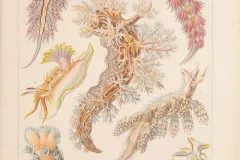Art Forms in Nature: Marine Species From Ernst Haeckel

Today’s discoveries about our planet’s biological diversity build upon the research of previous generations of scientists. The Biodiversity Heritage Library (BHL) is a digital library committed to providing free and open access to this treasure trove of information, much of which is held in the libraries of natural history research institutions around the world.
From recent articles published via premier scientific journals to monumental volumes marking the beginning of our study of the natural world, BHL’s collections include information about species from every corner of the globe and ecological niche. These digital collections are especially important for the works of the most influential men and women scientists of past centuries, books that because of their age and value are only available in a handful of libraries.
Of particular renown are the works of the German zoologist Ernst Haeckel.
Haeckel was born in 1834 in Potsdam, Germany (then Prussia). He served as a professor of comparative anatomy and director of the Zoological Institute at the University of Jena in Jena, Germany and was a member of more than 90 learned societies during his lifetime. Haeckel studied an array of zoological topics and he was the author of over 40 works and thousands of drawings. He is particularly remembered for his work on marine organisms like radiolarians, poriferans (sponges), and cnidarians (jellyfish, anemones and corals), including descriptions of several thousand new species. He had a deep personal interest in evolution, becoming the preeminent proponent of Darwinism in Germany and helping to popularize the theory throughout Europe. (Some of his evolutionary ideas did diverge in significant ways from Darwin’s theories, however.) He also served as a consultant on the Challenger expedition—the first non-commercial exploration of the deep-sea environment—that established the field of oceanography.
One of Haeckel’s most iconic publications is Kunstformen der Natur. The title translates into English as Art Forms in Nature, and the work is a landmark publication in the field of naturalist illustration. Published in sets of ten from 1899-1904 and together in two volumes in 1904, the work contains 100 lithographic prints produced by Adolf Giltsch from Haeckel’s original sketches and watercolors.
While much of it is stylized for artistic effect, the exquisitely drawn, detailed plates exhibiting Art Nouveau techniques alongside commentary accessible to the general public made Kunstformen der Natur an instant success. While Kunstformen der Natur covers a wide range of biological diversity, a majority of the illustrations depict marine life, which helped to popularize the scientific understanding of these little-known organisms.
You can learn more about Ernst Haeckel and Kunstformen der Natur in this online exhibit from The MBLWHOI Library. View the book in its entirety for free on the Biodiversity Heritage Library, digitized by Smithsonian Libraries, and browse all of the amazing illustrations in Flickr. The slideshow above is a taste of what you will find.

